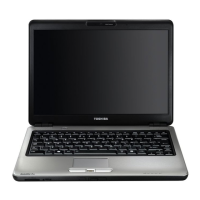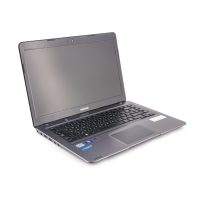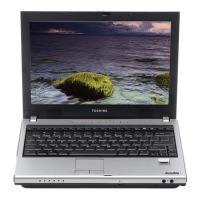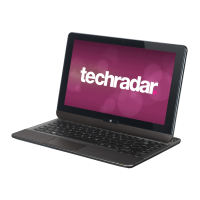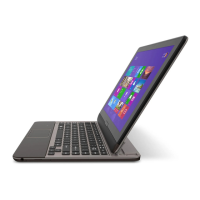
Do you have a question about the Toshiba Satellite U40t-A and is the answer not in the manual?
| Processor | Intel Core i5-4200U |
|---|---|
| Graphics | Intel HD Graphics 4400 |
| Operating System | Windows 8.1 |
| RAM | 4GB DDR3L |
| Storage | 500GB HDD |
| Display | 14.0" HD (1366x768) LED Backlit Touchscreen |
| Battery | 4-cell Li-Ion |
| Wireless | 802.11b/g/n |
| Ports | HDMI, Ethernet, SD card reader, headphone/microphone combo jack |
Covers copyright, disclaimer, and trademark information.
Details legal and regulatory compliance information.
Provides essential safety and handling guidelines.
Explains the meaning of safety icons used in the manual.
Information about ENERGY STAR compliance and energy saving.
Instructions for proper disposal of computer and batteries.
Reference to a separate safety and comfort manual.
Lists items included with the computer.
Explains formatting used in the manual.
Guides on initial setup and operation.
Instructions for connecting the AC power adapter.
How to open and adjust the computer display.
Steps to power on the computer.
Guidance for the initial operating system setup.
Introduction to Windows interface and features.
Instructions for shutting down the computer.
Steps for restarting the computer.
How to put the computer into Sleep Mode.
How to use Hibernation Mode.
Describes the front view of the computer with the display closed.
Details the ports and components on the left side.
Details the ports and components on the right side.
Describes the back view of the computer.
Details the components on the underside of the computer.
Shows the computer with the display open.
Explains the computer's internal hardware.
Explains computer power status indicators.
How to use the touch screen interface.
Guides on operating the touch pad.
Information about the computer's keyboard.
Details on battery types, use, and charging.
Information on connecting to a Local Area Network.
Information on using memory cards.
Connecting external displays via HDMI.
Lists available optional accessories.
Controls for audio and video settings.
Overview of pre-installed software utilities.
Unique or advanced computer features.
Setting up user and supervisor passwords.
Customizing hardware settings.
Utility to improve hard drive performance.
Manages power consumption and eco-mode features.
Multimedia playback software.
Customizing function key behavior.
For software updates and alerts.
Monitors system health and cooling.
Enhances video quality in Windows Media Player.
Adjusts audio settings and enhancements.
Options for recovering the system.
How to use USB ports for charging devices.
Steps to diagnose and resolve computer issues.
Basic checks to resolve common problems.
Methods to identify the root cause of issues.
Troubleshooting software-related problems.
Troubleshooting hardware-related problems.
Actions to take when unexpected issues occur.
Checks for hardware and peripheral issues.
What to do if the computer shuts down due to overheating.
Troubleshooting AC power connection issues.
Troubleshooting battery-related problems.
Troubleshooting display panel issues.
Troubleshooting hard disk drive problems.
Troubleshooting memory card issues.
Troubleshooting for pointing devices.
Troubleshooting USB device connection issues.
Troubleshooting the USB Sleep and Charge feature.
Troubleshooting audio issues.
Troubleshooting external monitor connection problems.
Troubleshooting network connectivity.
Troubleshooting wireless network connectivity.
Troubleshooting Bluetooth device connectivity.
How to contact TOSHIBA for assistance.
Accessing TOSHIBA's technical support website.
Technical specifications of the computer.
Physical measurements of the computer models.
Operating conditions for temperature and humidity.
Electrical specifications for AC adapter and computer.
Details about power cords and connectors.
List of certification agencies for the product.
Compliance and interoperability of wireless devices.
Compatibility of wireless technologies.
Health considerations for wireless device usage.
Information on Wireless LAN capabilities.
Details on Bluetooth functionality.
Establishing device-to-device connections.
Regulations for radio frequency usage.
Regulatory compliance specific to Canada.
FCC compliance information.
Taiwanese regulations on radio devices.
Specific usage guidelines for Japan.
Certifications for device components.
Approvals for wireless devices by region.
Explanations of terms and conditions.
Definitions of terms used in the manual.
